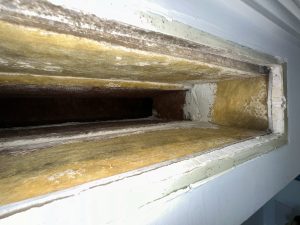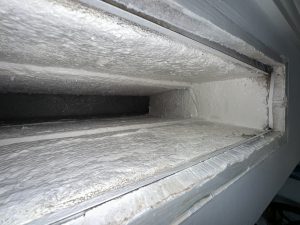Do you suspect mold in your ducts or have had a recent HVAC cleaning or maintenance? Perhaps you’ve stumbled upon “duct encapsulation” in your research on improving indoor air quality. This article explores duct encapsulation, its benefits, and signs indicating it might be necessary for your home.
What is Duct Encapsulation?
Duct encapsulation might sound technical, but it’s a simple concept. Imagine giving the inside of your air ducts a special coat of paint This coating offers some key advantages for your indoor air quality. It acts like a shield, making it harder for mold and bacteria to find a home inside your ducts. Even if a few mold spores are already present, the coating can prevent them from multiplying and causing bigger issues. The best part? These coatings are formulated to be low-VOC, so you won’t have to worry about harsh fumes filling your house during the application process.
Signs You Might Need Duct Encapsulation

While inspecting your entire ducts is ideal, here are some indicators that encapsulation could be beneficial:
- Visible white sealant flaking or peeling: This suggests existing encapsulation may be deteriorating.
- Fiberglass exposure: If you see exposed fiberglass insulation within your ducts, encapsulation is likely not present.
- Dust, mold, or staining inside your ducts: These signs suggest potential contamination requiring professional evaluation.
- Discoloration around vents: Discoloration near air vents might indicate duct leaks or mold growth.
- Musty odors or stuffy air: Unpleasant odors or a feeling of stale air could be caused by contaminants circulating through your ducts.
Seeking Professional Advice
Thinking about duct encapsulation to improve your indoor air quality? Hold on a sec! Before you jump in, consider talking to a qualified indoor air quality specialist or mold assessor. These experts can be your eyes and ears, literally! They’ll inspect your ducts, looking for leaks, mold, or anything else that might be causing problems. Then, based on what they find, they can recommend the best solution for you. Duct encapsulation can be great, but it’s not always the answer. A professional can help you address the root cause of your air quality concerns and choose the most effective approach for your unique situation.
Benefits of Duct Encapsulation:


Investing in duct encapsulation can offer a multitude of benefits for your home:
- Improved Indoor Air Quality: Encapsulation creates a barrier, effectively reducing allergens, dust, and other contaminants circulating through your HVAC system. This can lead to a healthier and more comfortable breathing environment for you and your family.
- Enhanced HVAC Efficiency: Leaky ducts force your HVAC system to work harder to maintain desired temperatures. Encapsulation seals these leaks, allowing your system to operate more efficiently and potentially lower your energy bills.
- Mold Prevention: The sealant coating creates a physical barrier and a less hospitable environment for mold growth. This can help prevent future mold problems within your ductwork.
- Extended Duct Lifespan: Encapsulation protects ducts from dust and debris accumulation, potentially extending their lifespan and reducing the need for premature replacements.
- Reduced Noise Levels: Some encapsulation materials can dampen noise transmission from your HVAC system, leading to a quieter and more peaceful living environment.
Alternatives to Duct Encapsulation:
While duct encapsulation offers a range of benefits, it’s not always the only solution for duct-related issues. Depending on the specific problem, alternatives like duct cleaning or replacement might be more suitable.
Professional duct cleaning can help remove dust, debris, and allergens accumulated within your ducts over time. Doing this can be a good option if leaks or mold growth aren’t major concerns. On the other hand, duct replacement is more for cases of severe damage, leaks, or significant mold contamination. With issues that extensive, replacing your entire duct system might be recommended.
What Is The Encapsulation Process?
The duct encapsulation process typically involves several steps:
- Preparation: A thorough cleaning of your ducts removes dust, debris, and any loose contaminants.
- Application: The sealant coating is carefully applied to the interior surfaces of your ducts.
- Curing Time: The sealant is allowed to cure completely, ensuring a strong and effective barrier.
Final Considerations for Encapsulation
Duct encapsulation can be a valuable investment for improving indoor air quality, enhancing HVAC efficiency, and promoting the overall health of your duct system. However, it’s crucial to seek professional advice to determine if it’s the most suitable solution for your specific needs.
